Nikon Nikkor Z 400 mm f/4.5 VR S
4. Image resolution
Like in a case of the Sigma S 500 mm f/5.6 DG DN OS, we have to describe the problem of the maximum performance of telephoto lenses as fast as f/4.5-6.3 in more detail. Why? It is obvious that the paragraph above, concerning resolution records, is not applicable. After all these records are reached when a fast lens is stopped down to f/2.8-4.0. As the tested lens doesn't feature such an aperture we simply cannot expect here results higher than 80 lpmm or anything even coming close to that level.
By and large, in this case the diffraction limit by f/5.6 is the absolute maximum you can count on. Trusting that the best f/1.2-1.8 lenses stopped down to f/5.6 so by about 4 EV, work already in their diffraction limit or very near it we can assume that such a limit reaches close to 76-78 lpmm. In case of telephoto lenses of 400-600 mm class the influence of micro-vibrations of the whole measuring system is more keenly felt and the stability of air in a distance of more than a dozen meters from the testing chart also should be taken into consideration; that's why we think that the lower borderline of near 76 lpmm would be a safer assumption to adopt.
Please Support UsIf you enjoy our reviews and articles, and you want us to continue our work please, support our website by donating through PayPal. The funds are going to be used for paying our editorial team, renting servers, and equipping our testing studio; only that way we will be able to continue providing you interesting content for free. |
- - - - - - - - - - - - - - - - - - - - - - - - - - - - - - - - - - - - - - - - - - - - - - - -
Still, there's a problem – in case of the tested Nikkor even that value seems to be very stringent; if the Nikkor reached it it would mean it works in the diffraction limit on stopping down the aperture by just 2/3 EV, an absolutely outstanding achievement. It's far more probable that a top-of-the-range fixed-focal lens will work in diffraction limit on stopping down the aperture by less than 2 EV so by f/8.0. In case of that relative aperture the diffraction limit reaches 66-68 lpmm on the Nikon Z7 sensor and such a lower borderline seems to be a good reference point in our test.
Being aware of that, you can take a closer look at the results the Nikkor Z 400 mm f/4.5 VR S in the frame centre, on the edge of the APS-C/DX sensor, and on the edge of full frame.
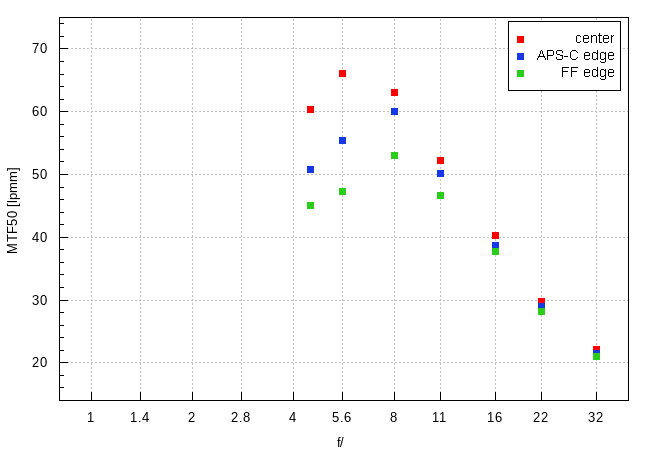
In the frame centre, at the maximum relative aperture, the tested lens slightly exceeds a very good level of 60 lpmm; on stopping down the aperture to f/5.6 it reaches the 66 lpmm limit, mentioned a while ago. Overall, a lens that works close to its diffraction limit on stopping down by 1 and 2/3 EV should be only praised.
When it comes to the edge of the frame we don't see any weak points so, once again, the lens performs beyond reproach. Still two things surprised us here: a difference between the edge and the frame centre is quite distinct and the peak of the performance is reached not by f/5.6 but only by f/8.0.
Of course it doesn't change the fact that the tested Nikkor Z 400 mm f/4.5 VR S is sharp across the frame up from the maximum relative aperture, a must-have feature of any top-of-the-range, fixed focal length instrument.
In case of this test we had an opportunity to check how the Nikkor performs when attached to the brand name 1.4x teleconverter that is able to change the parameters of the final set into 6.3/560.
Here, for obvious reasons, the criteria of our assessment have to change as well. After all such a set is as fast as f/6.3 and it would be difficult to expect its resolution exceeding distinctly 60 lpmm. A value of diffraction limit by f/11, amounting to 52-54 lpmm, would be a far more appropriate level. Let's check how the Nikkor with the teleconverter performs and how it compares.
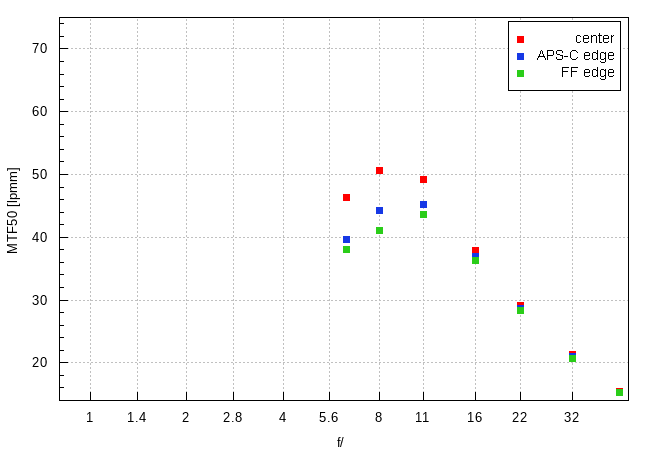
The limit, mentioned above, hasn't been met but if it had been it would have meant that the lens-plus-teleconverter set was as good as the lens itself. In the majority of cases, attaching a teleconverter lowers distinctly the performance of the whole system when compared to the performance of the lens itself so we shouldn't be surprised that the set, tested here, is not an exception to that rule.
Of course it doesn't change the fact that even in this case you deal with a good image quality already at the maximum relative aperture and, additionally, that quality starts to brush against very good values on stopping down the aperture to near f/8.0.
The edge of the frame is a far more serious problem. Off-axis aberrations, like lateral chromatic aberration, increase noticeably at that point and, as a result, the image quality at the maximum relative aperture is just on the decency level. In order to exceed that level, you have to stop the aperture down to near f/8.0. At the end of this chapter, traditionally, we present crops taken from photos of our resolution testing chart which were saved as JPEG files along the RAW files, used for the analysis above.
| Nikon Z7, JPEG, 400 mm, f/4.5 |
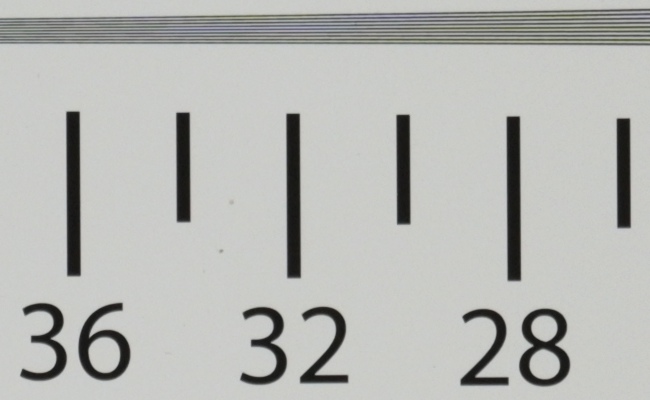 |
| Nikon Z7, JPEG, 400 mm, f/5.6 |
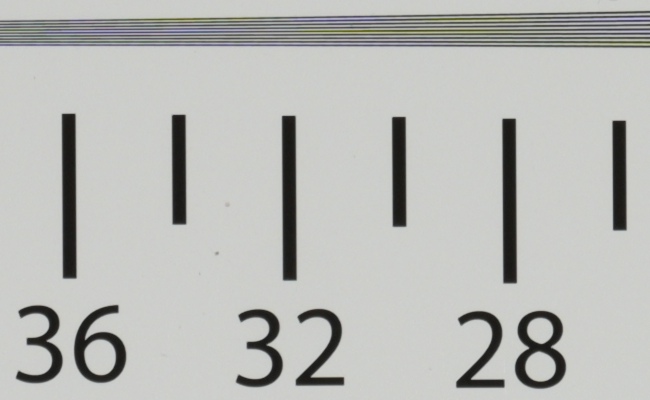 |
| Nikon Z7, JPEG, 560 mm (TC), f/6.3 |
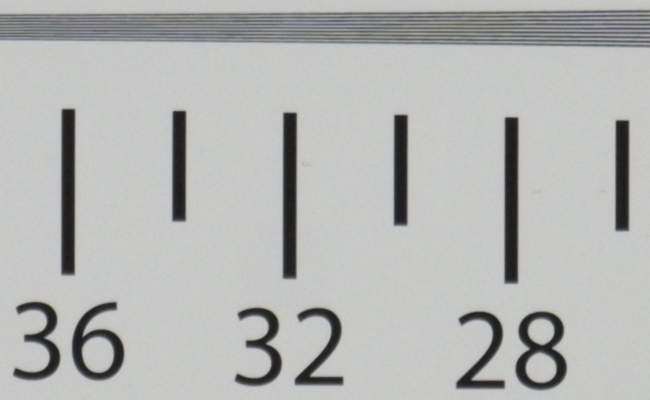 |
| Nikon Z7, JPEG, 560 mm (TC), f/8.0 |
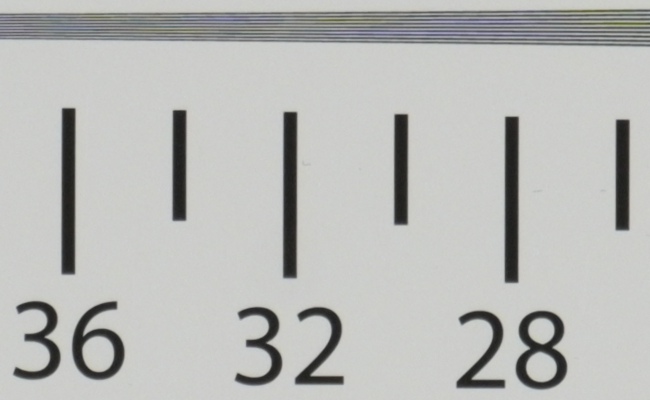 |






